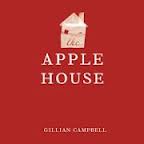The Apple House
By Gillian Campbell
Brindle & Glass, 240 pages, $19.95
Reviewed by Jennifer Kingsley
I loved the shoes! They are everywhere in this charming story about life on the West Island near Montreal, Quebec, and they will make you pay attention to footwear everywhere you go. In the novel, shoes spark new love, beckon the unknown, weather the years like old friends and represent a time when handmade objects held real value. The shoes are perfect for a story that centres on Imogen Jackson’s life and love affair with the town cobbler, Thomas Laviolette. When Thomas’ death is foretold in the first few pages, Imogen must sort out the family shoe store and come to grips with her future and her past.
B.C. author Gillian Campbell fills The Apple House with life-affirming details that ground this 1970s story in reality. The Apple House itself is a clapboard building that sits down the street from Imogen’s childhood home. This house was the site of early childhood romps and raids for the protagonist and her friends. It resurfaces as the fixer-upper she and Thomas planned to live in before his death by car accident. It takes on further meaning when Thomas’s trouble making friend moves in after Thomas’s death.
The house helps to connect the narrative, which unfolds in three interwoven time periods. Although the reader may find the multiple narratives and shifting points of view (Campbell uses first, second and third person) confusing at the outset, Campbell soon trains you to shift from place to place. For me, the childhood narrative sometimes lagged behind the others, but the different threads allowed compelling and diverse scenes to emerge. The funeral of an old man, for example, is replete with sharp details that would only be remembered by a child. The shoe store, on the other hand, evokes anxieties that we only encounter in adulthood.
The Apple House draws out the contrasts of life in small-town Canada, and that is one of its greatest strengths. While life-long relationships build a strong community, they also make it hard for characters to change. Misunderstandings can last for years. Also, small objects and a shared landscape create a culture that is unique to each town — whether it is a French and English village from 40 years ago or the communities we live in now.
Campbell has embedded worth in her first novel by using a tiny geography to sketch the drama of a close-knit community, thereby reminding us of the power of everyday objects.
Jennifer Kingsley is a writer and broadcaster based in the small town of Almonte, Ontario.
